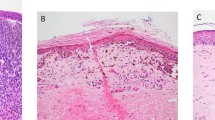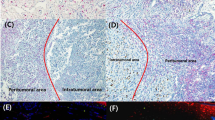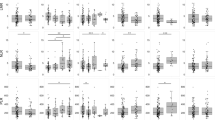Abstract
Very rapid progression of disease with a median survival of 6-9 months is a common feature of metastatic cutaneous malignant melanoma. Nevertheless, substantial variability of survival suggests that metastatic cutaneous malignant melanoma can be divided into several biological subgroups. Pretreatment serum levels of soluble adhesion molecules and various clinical parameters in cutaneous metastatic malignant melanoma were evaluated to determine their prognostic value. In this study pretreatment serum levels of soluble vascular cell adhesion molecule 1 (sVCAM-1), soluble intercellular cell adhesion molecule 1 (sICAM-1), soluble endothelial leukocyte adhesion molecule 1 (sE-selectin) and multiple clinical factors were assessed in relation to overall survival of 97 consecutive patients with metastatic cutaneous malignant melanoma seen at our institution between May 1990 and April 1996. For statistical analysis, both univariate and multivariate Cox proportional-hazards models were used. Elevated pretreatment serum levels of sVCAM-1 (P < 0.005) and of lactate dehydrogenase (P < 0.002) were rendered statistically independent and were significantly associated with unfavourable outcome. Patients were assigned to one of three risk categories (low, intermediate and high) according to a cumulative risk score defined as the function of the sum of these two variables. There were significant differences in overall survival (P < 0.0001) between low- (n = 53, 5-year survival probability of 23.3%), intermediate- (n = 29, 5-year survival probability of 9.9%) and high-risk (n = 15) patients. Elevated pretreatment serum levels of sVCAM-1 and of lactate dehydrogenase correlate with poor outcome in metastatic cutaneous malignant melanoma. These data support risk stratification for future therapeutic trials and identify factors that need to be validated in prospective studies and may potentially influence decision-making in palliative management of patients with disseminated cutaneous malignant melanoma.
This is a preview of subscription content, access via your institution
Access options
Subscribe to this journal
Receive 24 print issues and online access
$259.00 per year
only $10.79 per issue
Buy this article
- Purchase on Springer Link
- Instant access to full article PDF
Prices may be subject to local taxes which are calculated during checkout
Similar content being viewed by others
Author information
Authors and Affiliations
Rights and permissions
About this article
Cite this article
Franzke, A., Probst-Kepper, M., Buer, J. et al. Elevated pretreatment serum levels of soluble vascular cell adhesion molecule 1 and lactate dehydrogenase as predictors of survival in cutaneous metastatic malignant melanoma. Br J Cancer 78, 40–45 (1998). https://doi.org/10.1038/bjc.1998.439
Issue Date:
DOI: https://doi.org/10.1038/bjc.1998.439
This article is cited by
-
Clinical characteristics and prognostic indicators for metastatic melanoma: data from 446 patients in north China
Tumor Biology (2016)
-
Protein and non-protein biomarkers in melanoma: a critical update
Amino Acids (2012)
-
Celecoxib modulates adhesion of HT29 colon cancer cells to vascular endothelial cells by inhibiting ICAM‐1 and VCAM‐1 expression
British Journal of Pharmacology (2008)
-
Serum levels of intercellular adhesion molecule ICAM-1 and E-selectin in advanced stage non-small cell lung cancer
Medical Oncology (2008)



